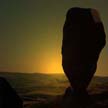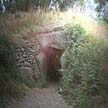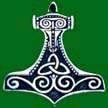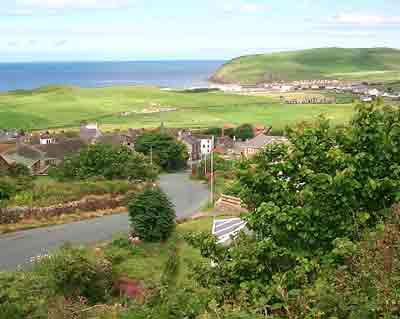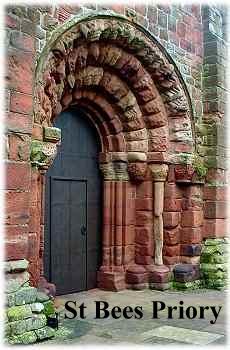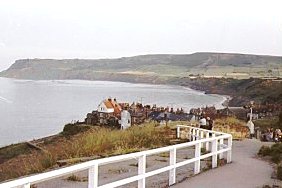Take the stone my mother made
On a silken thread let it swing free
To guide you along the lines of force
From the Western Cliff to the Eastern sea,
Take to the land and follow the ley
Along the journey there are references to many of the prominent featues of the landscape and the legends and events associated with them. The ubiquitous Robin Hood has one of his supposed graves on the Westmorland limestone plateau in the Vale of Eden, his 'chair' is at the side of Ennerdale Lake and his tower is at Richmond Castle.
The castle on the mighty rock
Standing high above the Swale
Look to the east from the green man's hall,
To the Cleveland Scarps across the Vale.
There are references to the Celtic St. Bega, after whom St. Bees is named, prehistoric monuments along the way like Bridestones Ring, the Nine Standards on the summit of the Pennines, the Handstone on Urra Moor and the cup-and-ring and swastika markings on Rombald's Moor which have never been fully explained.
The references to places are incidental to the structure of The Pathfinder , which is as much a journey through time as across the country. The distant past is dovetailed with the flashy present in 'Tourist Town' or 'Pendulum Clock', a glimpse back into the recent past through the eyes of an old man met in Swaledale. The old story about the Cork Peddler refers to the innumerable landmarks for the walker there are on the Cleveland Hills, all indicating unknown or forgotten peoples.
Since the autumn, Malcolm Laws has been setting The Pathfinder and both he and Jim have been making a tape of the hour long work. They are both involved in the Waggonners Folk Club which helped in the fund-raising concert in January for the Oughtershaw Centre Appeal, and they played two sections from Pathfinder on that occasion - with help from other musicians, including Bob Pegg.
But to make the tape they have to do all the vocals and play all the instruments themselves, and using a domestic stereo tape machine means that they have to go through each section again and again, each time adding a different part. They both sing, and between them play guitars, flutes, banjo, recorders, whistles, fiddle, concertina, mandolin and keyboards.
The tape is now nearing completion, and with that, and the instrumental parts scored by Malcolm, they will have a unique piece of folk history and music that can be performed by a larger group.
There is no label that can adequately describe The Pathfinder, but it is clear that it would make an impressive and original LP, and it is hoped that it will be available on a wider basis in this form before long.
Margaret Grimsdell
(Published in Yorkshire Arts Magazine 1976)
